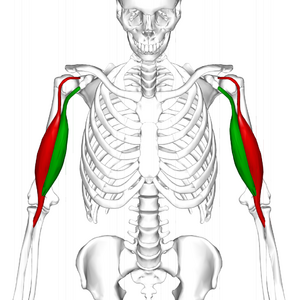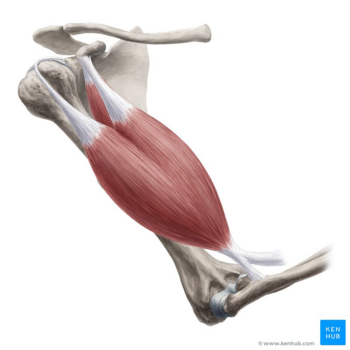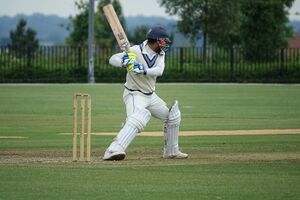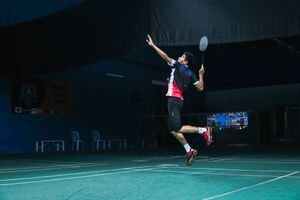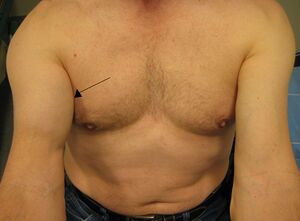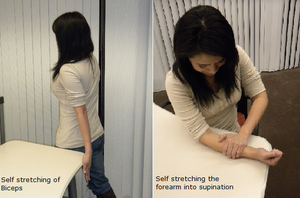Biceps Brachii: Difference between revisions
No edit summary |
Kim Jackson (talk | contribs) No edit summary |
||
| (41 intermediate revisions by 9 users not shown) | |||
| Line 4: | Line 4: | ||
'''Top Contributors''' - {{Special:Contributors/{{FULLPAGENAME}}}} | '''Top Contributors''' - {{Special:Contributors/{{FULLPAGENAME}}}} | ||
</div> | </div> | ||
== | == Introduction == | ||
[[File:Biceps brachii.png|right|frameless]] | |||
The biceps brachii (BB), commonly know as the biceps, is a large, thick [[muscle]] on the ventral portion of the upper arm. | |||
The muscle is composed of a short head and a long head. The long head is located on the lateral side of the biceps brachii while the short head is located on the medial side<ref>Weebly Biceps brachii Available:https://bicepsbrachii.weebly.com/fun-facts.html (accessed 10.1.2022)</ref>. | |||
The biceps brachii works across three joints, and is able to generate movements in [[Glenohumeral Joint|glenohumeral]], [[elbow]] and radio-ulnar joints. | |||
Image 1: ''':''' Biceps brachii muscle. - Long head red, Short head green. | |||
== Origin and Insertion == | |||
[[File:Biceps attachments.png|right|frameless|509x509px]] | |||
The muscle is composed of a short head and a long head. | |||
= | # The short head originates from the apex of the coracoid process of the [[scapula]].<ref name=":0">Moore KL, Dalley AF, Agur AM. Clinically oriented anatomy. Lippincott Williams & Wilkins; 2013 Feb 13.</ref> | ||
# The long head originates from the supraglenoid tubercle of the scapula. | |||
Both heads course distally and become a confluent muscle belly before tapering across the anterior aspect of the [[elbow]], to insert on the radial tuberosity and the [[fascia]] of the forearm via the bicipital [[aponeurosis]].<ref name=":1">Tiwana MS, Charlick M, Varacallo M. [https://www.ncbi.nlm.nih.gov/books/NBK519538/ Anatomy, Shoulder and Upper Limb, Biceps Muscle.] [Updated 2021 Aug 11]. In: StatPearls [Internet]. Treasure Island (FL): StatPearls Publishing; 2021 Jan-. Available from: https://www.ncbi.nlm.nih.gov/books/NBK519538/ (accessed 10.1.2022)</ref> | |||
= | Approximately 30% of adults have some variation in the origin of the muscle. In many patients, a third head may arise from the humerus, but in about 2% to 5% of people, there may be supernumerary heads numbering anywhere from 3 to 7 in total.<ref name=":1" /> | ||
Image 2: Biceps brachii of right side, attachments. | |||
== | == Nerve and Arterial Supply == | ||
Innervation of bicep brachii is by the [[Musculocutaneous Nerve|musculocutaneous nerve]] C5, '''C6''', C7.<ref name=":0" /> | |||
[[Blood]] supplied by the muscular branches of brachial [[Arteries|artery]]<ref name=":0" /> | |||
== | == Function == | ||
[[File:Biceps brachii muscle - Kenhub.png|alt=Biceps brachii in elbow flexion|right|frameless|350x350px|Biceps brachii in elbow flexion]] | |||
The main functions of the biceps are the flexion and supination (outward rotation) of the forearm. This is facilitated, in part, by the 90-degree rotation of the muscle as it connects to the radius. <ref name=":4" /> | |||
* Contrary to popular belief, the biceps is not the most powerful flexor of the forearm. Although the biceps is the most prominent muscle of the upper arm, it primarily serves to support and stabilize the deeper (and stronger) [[brachialis]] muscle whenever lifting or lowering the forearm<ref name=":3">Plantz MA, Bordoni B. [https://www.ncbi.nlm.nih.gov/books/NBK551630/ Anatomy, Shoulder and Upper Limb, Brachialis Muscle.] Available: https://www.ncbi.nlm.nih.gov/books/NBK551630/<nowiki/>(accessed 10.1.2022)</ref><ref name=":4">Very well health Biceps Available:https://www.verywellhealth.com/biceps-anatomy-4688616 (accessed 10.1.2022)</ref>. | |||
* The brachialis muscle is the strongest flexor of the elbow in the absence of supination, with supination and flexion, its mechanical momentum becomes more disadvantaged than the biceps brachialis muscle.<ref name=":3" /> | |||
= | The BB has a smaller role in shoulder flexion. The BBLH is thought to enhance the dynamic stability of the shoulder joint, but only in the initial 30° of elevation. <ref name=":2" /> This role is significant in eg. allowing us to carry heavy weights when the arm is in an extended downward position. | ||
Image 3: Biceps brachii in elbow flexion <ref > Biceps brachii muscle in elbow flexion image - © Kenhub https://www.kenhub.com/en/library/anatomy/biceps-brachii-muscle</ref> | |||
Biceps works with other muscles in its roles being: | |||
= | # One of three muscles that flex the elbow and it does this work along with the brachialis and [[Brachioradialis|brachioradialis.]] | ||
# One of three that flex the shoulder (with [[Coracobrachialis Muscle|coracobrachialis]] and anterior [[deltoid]]) | |||
# One of two that supinate the forearm (with supinator). <ref name=":2">Landin D, Thompson M, Jackson MR. [https://www.ncbi.nlm.nih.gov/pmc/articles/PMC5505302/ Actions of the biceps brachii at the shoulder: a review]. Journal of clinical medicine research. 2017 Aug;9(8):667.Available: https://www.ncbi.nlm.nih.gov/pmc/articles/PMC5505302/ (accessed 10.1.2022)</ref> | |||
== Physiotherapy == | |||
[[File:Cricket match.jpeg|right|frameless]]The biceps are involved in such tasks eg lifting, sports involving throwing and racket use (eg baseball and cricket, badminton and tennis) and gesturing. As a result, [[Biceps Tendinopathy|biceps tendinopathy]] are common conditions sees in the muscle.<ref name=":0" />. Most occur as a result of physical trauma or [[Overuse Injuries - an Individualised Approach|repetitive activity]].<ref name=":4" /> | |||
LHB tendinopathy | |||
* Occur in association with RC pathology, [[Subacromial Pain Syndrome|Subacromial impingement syndrome]], or in tandem with subscapularis injuries. | |||
* In the setting of RC tears, 90% of cases demonstrated concomitant LHB tendinopathy, and 45% of cases had additional LHB instability<ref>[[Biceps Tendinopathy]]</ref>. | |||
[[File:Badminton.jpeg|right|frameless]] | |||
Among some of the more common conditions affecting the biceps: | |||
* Biceps [[Muscle Strain|strains]] | |||
* Partial tendon tears, involving either the proximal tendon near the shoulder or the distal tendon near the elbow (in addition to physical trauma, the degeneration of the tendon due to age or repetitive use can cause partial tears). | |||
* Complete tendon tears, occur when a [[Rupture Long Head Biceps|biceps tendon ruptures]] and separates from the scapula or, less commonly, the elbow. | |||
* [[Biceps Tendinopathy|Insertional tendonitis]] is the inflammation of the tendon at the site where it connects with bone<ref name=":4" />. | |||
Images 4 and 5: Sports involving throwing and racket use. | |||
== | == Assessment == | ||
[[File:Biceps tendon tear.jpeg|right|frameless]] | |||
Detailed history should be completed prior to physical examinations. A basic examination should include observation, palpation, [[Manual Muscle Testing: Elbow Extension|muscle strength testing]] and [[Range of Motion|range of motion]]. Obvious deformity, known as "Popeye sign", might be observed with rupture of long head tendon of the biceps.<ref>Yoshida N, Tsuchida Y. “Popeye” sign. N Engl J Med. 2017 Nov 16;377:1976.</ref> | |||
Image 6: Popeye sign, biceps brachii | |||
* Palpation of the anterior aspect of the arm should include the full length of the muscle. Tenderness similar to patient's complaint might be reproduced via palpation. It is also useful to locate the site of injury. | |||
* Muscle strength test of the biceps should be completed in supine of sitting with patient's arm well support by a cushion of a hand of the examiner. Patient's elbow positioned slightly less than or at right angle with forearm in supination. Examiner should then apply pressure against the lower forearm in the direction of extension.<ref name="Florence P.muscles testing and function with posture and pain.1993">Kendall FP, McCreary EK, Provance PG, Rodgers M, Romani WA. Muscles, testing and function: with posture and pain. Baltimore, MD: Williams & Wilkins; 1993.</ref> Weakness might present with patient symptoms. | |||
* Examiner could observe the range of motion of the elbow using a goniometre. Examiner can also palpate and look for crepitus in the elbow joint.<br>palpation | |||
* Muscle length test: see video below{{#ev:youtube|SSepwDda21Y}} | |||
= | == Treatment == | ||
[[File:Biceps stretch.png|right|frameless]] | |||
Most injuries involving the biceps will heal on their own without the need for surgery. Acute injuries may be treated for the first 48 to 72 hours with a therapeutic practice known by acronym [[POLICE Principle]] <ref name=":4" /> | |||
Physiotherapy is often needed to rehabilitate the muscle. | |||
Image 7: Biceps stretch. | |||
See also | |||
[[Rupture Long Head Biceps | * [[Rupture Long Head Biceps]] | ||
* [[Biceps Load II Test]] | |||
* [[Biceps Tendonitis]] | |||
* [[Yergasons Test]] | |||
== Resources == | |||
'''Viewing''' | |||
The video below explores the anatomy of the Biceps Brachii <ref> Biceps brachii muscle video - © Kenhub https://www.kenhub.com/en/library/anatomy/biceps-brachii-muscle</ref>{{#ev:youtube|v0GJltQp6R0}} | |||
=== Strengthening === | |||
{{#ev:youtube|n4meWitwBmU}}<ref>Availble from:Canadian Chiropractic Guideline Initiative (CCGI).https://www.youtube.com/watch?v=n4meWitwBmU. Biceps strengthening (standing)* {last accessed 28 June 2021}</ref> | |||
=== Stretching === | |||
{{#ev:youtube|QY4gCIYbGQk}}<ref>Availble from:BaptistHealthSF.https://www.youtube.com/watch?v=QY4gCIYbGQk. Bicep Stretch {last accessed 28 June 2021}</ref> | |||
= | === Myofascial release technique === | ||
< | {{#ev:youtube|F_vTCdcUD_8}}<ref>Availble from:Brian Abelson.https://www.youtube.com/watch?v=F_vTCdcUD_8. Self Myofascial Release - Biceps{last accessed 28 June 2021}</ref> | ||
= References | == References == | ||
<references /> | <references /> | ||
[[Category:Anatomy]] [[Category:Muscles]] | [[Category:Anatomy]] | ||
[[Category:Muscles]] | |||
[[Category:Shoulder]] | |||
[[Category:Shoulder - Anatomy]] | |||
[[Category:Shoulder - Muscles]] | |||
[[Category:Elbow]] | |||
[[Category:Elbow - Anatomy]] | |||
[[Category:Elbow - Muscles]] | |||
Latest revision as of 13:09, 14 March 2023
Original Editor - Esraa Mohamed Abdullzaher
Top Contributors - Esraa Mohamed Abdullzaher, Lucinda hampton, Kim Jackson, Joao Costa, Sai Kripa, Hing Long Yip, 127.0.0.1, Admin, George Prudden, WikiSysop and Wendy Snyders
Introduction[edit | edit source]
The biceps brachii (BB), commonly know as the biceps, is a large, thick muscle on the ventral portion of the upper arm.
The muscle is composed of a short head and a long head. The long head is located on the lateral side of the biceps brachii while the short head is located on the medial side[1].
The biceps brachii works across three joints, and is able to generate movements in glenohumeral, elbow and radio-ulnar joints.
Image 1: : Biceps brachii muscle. - Long head red, Short head green.
Origin and Insertion[edit | edit source]
The muscle is composed of a short head and a long head.
- The short head originates from the apex of the coracoid process of the scapula.[2]
- The long head originates from the supraglenoid tubercle of the scapula.
Both heads course distally and become a confluent muscle belly before tapering across the anterior aspect of the elbow, to insert on the radial tuberosity and the fascia of the forearm via the bicipital aponeurosis.[3]
Approximately 30% of adults have some variation in the origin of the muscle. In many patients, a third head may arise from the humerus, but in about 2% to 5% of people, there may be supernumerary heads numbering anywhere from 3 to 7 in total.[3]
Image 2: Biceps brachii of right side, attachments.
Nerve and Arterial Supply[edit | edit source]
Innervation of bicep brachii is by the musculocutaneous nerve C5, C6, C7.[2]
Blood supplied by the muscular branches of brachial artery[2]
Function[edit | edit source]
The main functions of the biceps are the flexion and supination (outward rotation) of the forearm. This is facilitated, in part, by the 90-degree rotation of the muscle as it connects to the radius. [4]
- Contrary to popular belief, the biceps is not the most powerful flexor of the forearm. Although the biceps is the most prominent muscle of the upper arm, it primarily serves to support and stabilize the deeper (and stronger) brachialis muscle whenever lifting or lowering the forearm[5][4].
- The brachialis muscle is the strongest flexor of the elbow in the absence of supination, with supination and flexion, its mechanical momentum becomes more disadvantaged than the biceps brachialis muscle.[5]
The BB has a smaller role in shoulder flexion. The BBLH is thought to enhance the dynamic stability of the shoulder joint, but only in the initial 30° of elevation. [6] This role is significant in eg. allowing us to carry heavy weights when the arm is in an extended downward position.
Image 3: Biceps brachii in elbow flexion [7]
Biceps works with other muscles in its roles being:
- One of three muscles that flex the elbow and it does this work along with the brachialis and brachioradialis.
- One of three that flex the shoulder (with coracobrachialis and anterior deltoid)
- One of two that supinate the forearm (with supinator). [6]
Physiotherapy[edit | edit source]
The biceps are involved in such tasks eg lifting, sports involving throwing and racket use (eg baseball and cricket, badminton and tennis) and gesturing. As a result, biceps tendinopathy are common conditions sees in the muscle.[2]. Most occur as a result of physical trauma or repetitive activity.[4]
LHB tendinopathy
- Occur in association with RC pathology, Subacromial impingement syndrome, or in tandem with subscapularis injuries.
- In the setting of RC tears, 90% of cases demonstrated concomitant LHB tendinopathy, and 45% of cases had additional LHB instability[8].
Among some of the more common conditions affecting the biceps:
- Biceps strains
- Partial tendon tears, involving either the proximal tendon near the shoulder or the distal tendon near the elbow (in addition to physical trauma, the degeneration of the tendon due to age or repetitive use can cause partial tears).
- Complete tendon tears, occur when a biceps tendon ruptures and separates from the scapula or, less commonly, the elbow.
- Insertional tendonitis is the inflammation of the tendon at the site where it connects with bone[4].
Images 4 and 5: Sports involving throwing and racket use.
Assessment[edit | edit source]
Detailed history should be completed prior to physical examinations. A basic examination should include observation, palpation, muscle strength testing and range of motion. Obvious deformity, known as "Popeye sign", might be observed with rupture of long head tendon of the biceps.[9]
Image 6: Popeye sign, biceps brachii
- Palpation of the anterior aspect of the arm should include the full length of the muscle. Tenderness similar to patient's complaint might be reproduced via palpation. It is also useful to locate the site of injury.
- Muscle strength test of the biceps should be completed in supine of sitting with patient's arm well support by a cushion of a hand of the examiner. Patient's elbow positioned slightly less than or at right angle with forearm in supination. Examiner should then apply pressure against the lower forearm in the direction of extension.[10] Weakness might present with patient symptoms.
- Examiner could observe the range of motion of the elbow using a goniometre. Examiner can also palpate and look for crepitus in the elbow joint.
palpation - Muscle length test: see video below
Treatment[edit | edit source]
Most injuries involving the biceps will heal on their own without the need for surgery. Acute injuries may be treated for the first 48 to 72 hours with a therapeutic practice known by acronym POLICE Principle [4]
Physiotherapy is often needed to rehabilitate the muscle.
Image 7: Biceps stretch.
See also
Resources[edit | edit source]
Viewing
The video below explores the anatomy of the Biceps Brachii [11]
Strengthening[edit | edit source]
Stretching[edit | edit source]
Myofascial release technique[edit | edit source]
References[edit | edit source]
- ↑ Weebly Biceps brachii Available:https://bicepsbrachii.weebly.com/fun-facts.html (accessed 10.1.2022)
- ↑ 2.0 2.1 2.2 2.3 Moore KL, Dalley AF, Agur AM. Clinically oriented anatomy. Lippincott Williams & Wilkins; 2013 Feb 13.
- ↑ 3.0 3.1 Tiwana MS, Charlick M, Varacallo M. Anatomy, Shoulder and Upper Limb, Biceps Muscle. [Updated 2021 Aug 11]. In: StatPearls [Internet]. Treasure Island (FL): StatPearls Publishing; 2021 Jan-. Available from: https://www.ncbi.nlm.nih.gov/books/NBK519538/ (accessed 10.1.2022)
- ↑ 4.0 4.1 4.2 4.3 4.4 Very well health Biceps Available:https://www.verywellhealth.com/biceps-anatomy-4688616 (accessed 10.1.2022)
- ↑ 5.0 5.1 Plantz MA, Bordoni B. Anatomy, Shoulder and Upper Limb, Brachialis Muscle. Available: https://www.ncbi.nlm.nih.gov/books/NBK551630/(accessed 10.1.2022)
- ↑ 6.0 6.1 Landin D, Thompson M, Jackson MR. Actions of the biceps brachii at the shoulder: a review. Journal of clinical medicine research. 2017 Aug;9(8):667.Available: https://www.ncbi.nlm.nih.gov/pmc/articles/PMC5505302/ (accessed 10.1.2022)
- ↑ Biceps brachii muscle in elbow flexion image - © Kenhub https://www.kenhub.com/en/library/anatomy/biceps-brachii-muscle
- ↑ Biceps Tendinopathy
- ↑ Yoshida N, Tsuchida Y. “Popeye” sign. N Engl J Med. 2017 Nov 16;377:1976.
- ↑ Kendall FP, McCreary EK, Provance PG, Rodgers M, Romani WA. Muscles, testing and function: with posture and pain. Baltimore, MD: Williams & Wilkins; 1993.
- ↑ Biceps brachii muscle video - © Kenhub https://www.kenhub.com/en/library/anatomy/biceps-brachii-muscle
- ↑ Availble from:Canadian Chiropractic Guideline Initiative (CCGI).https://www.youtube.com/watch?v=n4meWitwBmU. Biceps strengthening (standing)* {last accessed 28 June 2021}
- ↑ Availble from:BaptistHealthSF.https://www.youtube.com/watch?v=QY4gCIYbGQk. Bicep Stretch {last accessed 28 June 2021}
- ↑ Availble from:Brian Abelson.https://www.youtube.com/watch?v=F_vTCdcUD_8. Self Myofascial Release - Biceps{last accessed 28 June 2021}
